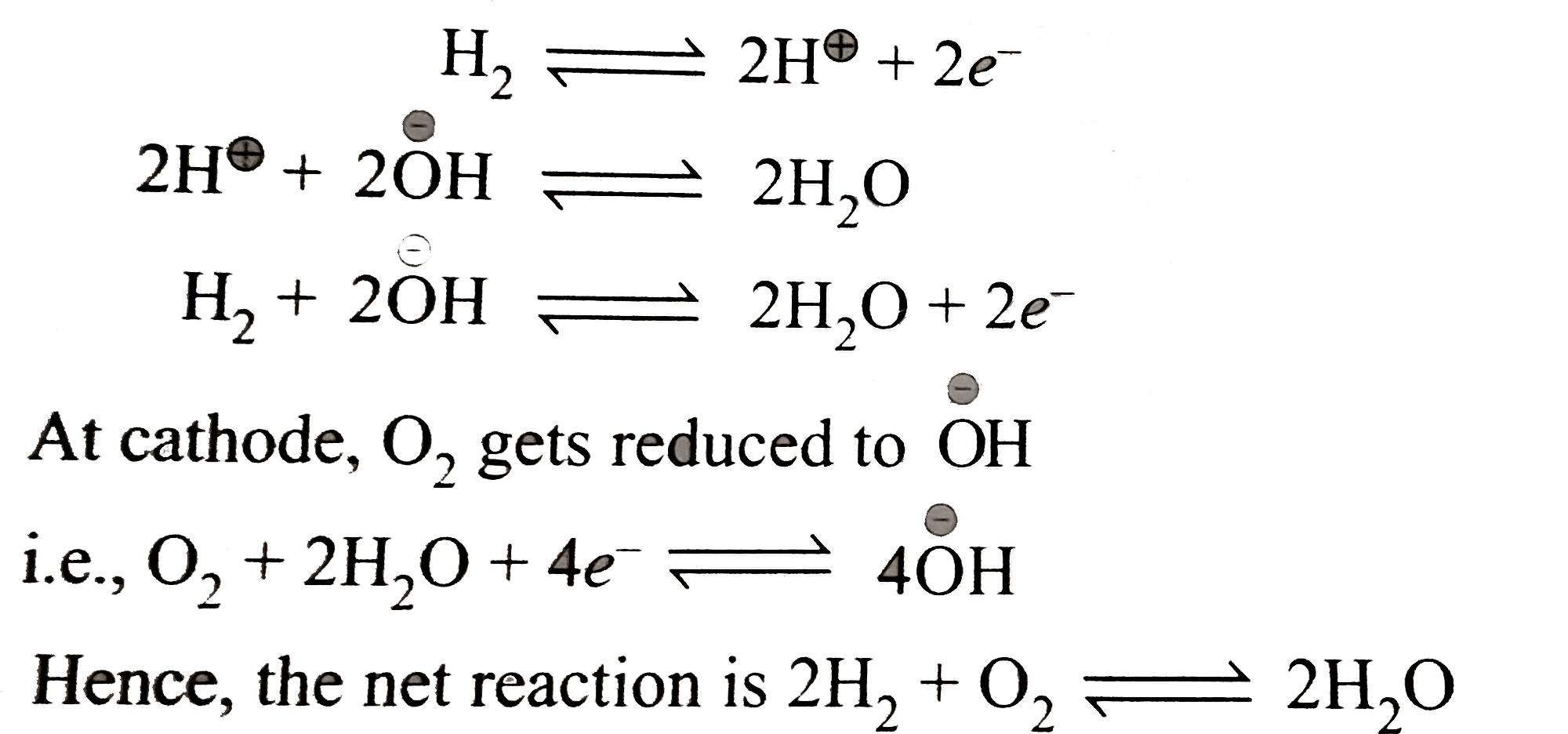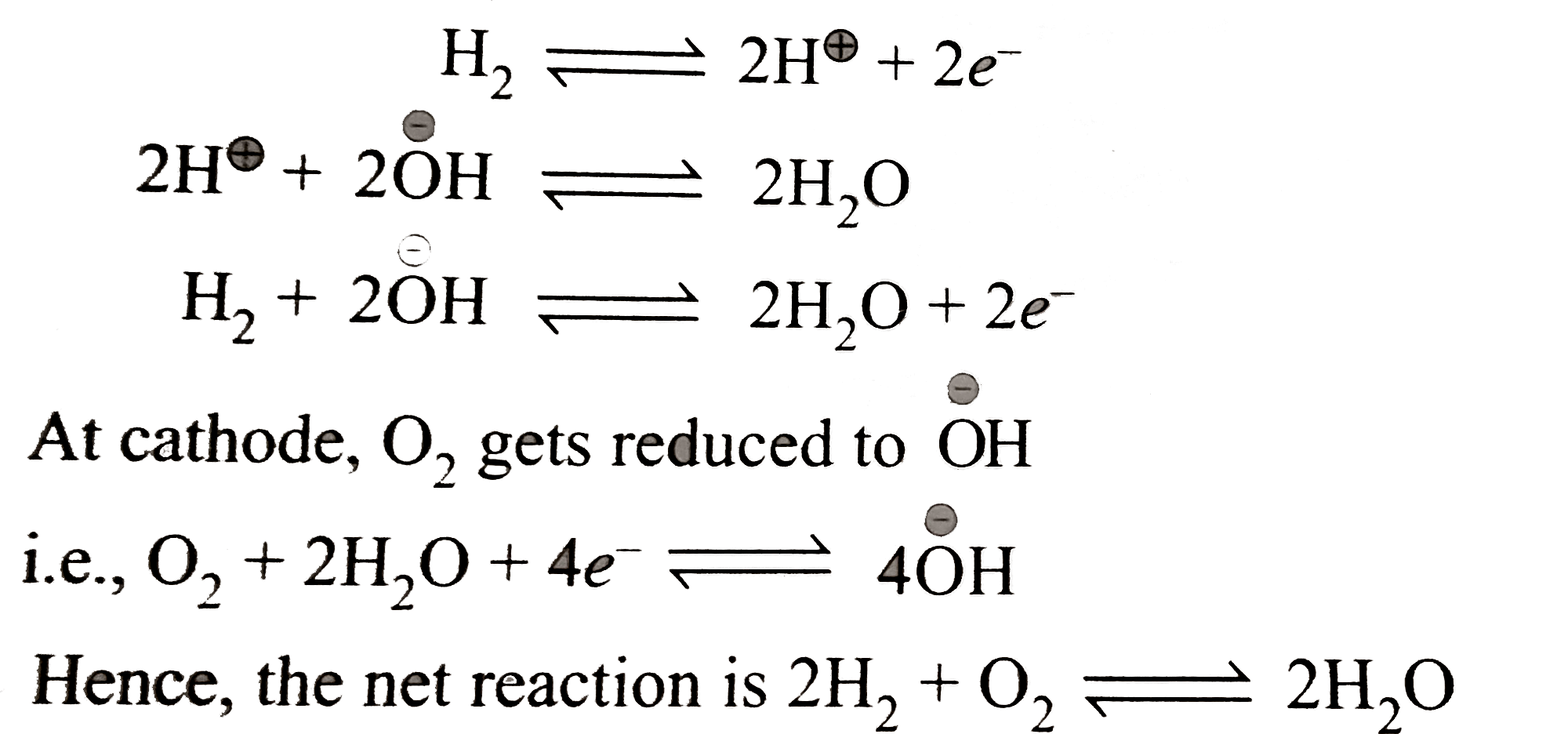Complete Solutions to COMPETITION FILE (OBJECTIVE TYPE QUESTIONS) D MULTIPLE CHOICE QUESTIONS of chapter ELECTROCHEMISTRY of Class 12 book with complete answers and questions
| Class 12 | CHEMISTRY |
| Chapter | ELECTROCHEMISTRY |
| MODERN PUBLICATION | COMPETITION FILE (OBJECTIVE TYPE QUESTIONS) D MULTIPLE CHOICE QUESTIONS |
| Number Of Questions | 12 |
| Academic Year | 2023-24 |
Fuel cells `:` Fuel cells are galvanic cells in which the chemical energy of fuel cell is directly converted into electrical energy. A type of fuel cell is a hydrogen `-` oxygen fuel cell. It consists of two electrodes made up of two porous graphite impregnated with a catalyst `(` platinum, silver, or metal oxide `).` The electrodes are placed in aqueous solution of `NaOH` . Oxygen and hydrogen are continuously fed into the cell. Hydrogen gets oxidized to `H^(o+)` which is neutralized by `overset(c-)(O)H, i.e.,` anodic reaction.

At cathode, `O_(2)` gets reduced to `overset(c-)(O)H`
Hence, the net reaction is
The overall reaction has
`DeltaH=-285.6 kJ mol^(-1)` and `DeltaG=-237.4 kJ mol^(-1)` at `25^(@)C`
What is the value of `DeltaS^(c-)` for the fuel cell at `25^(@)C`?08:04View SolutionFuel cells `:` Fuel cells are galvanic cells in which the chemical energy of fuel cell is directly converted into electrical energy. A type of fuel cell is a hydrogen `-` oxygen fuel cell. It consists of two electrodes made up of two porous graphite impregnated with a catalyst `(` platinum, silver, or metal oxide `).` The electrodes are placed in aqueous solution of `NaOH` . Oxygen and hydrogen are continuously fed into the cell. Hydrogen gets oxidized to `H^(o+)` which is neutralized by `overset(c-)(O)H, i.e.,` anodic reaction.

At cathode, `O_(2)` gets reduced to `overset(c-)(O)H`

Hence, the net reaction is
The overall reaction has
`DeltaH=-285.6 kJ mol^(-1)` and `DeltaG=-237.4 kJ mol^(-1)` at `25^(@)C`
If the cell voltage is `1.23V` for the `H_(2)-O_(2)` fuel cell and for the half cell `:`08:04View SolutionFuel cells `:` Fuel cells are galvanic cells in which the chemical energy of fuel cell is directly converted into electrical energy. A type of fuel cell is a hydrogen `-` oxygen fuel cell. It consists of two electrodes made up of two porous graphite impregnated with a catalyst `(` platinum, silver, or metal oxide `).` The electrodes are placed in aqueous solution of `NaOH` . Oxygen and hydrogen are continuously fed into the cell. Hydrogen gets oxidized to `H^(o+)` which is neutralized by `overset(c-)(O)H, i.e.,` anodic reaction.

At cathode, `O_(2)` gets reduced to `overset(c-)(O)H`

Hence, the net reaction is
The overall reaction has
`DeltaH=-285.6 kJ mol^(-1)` and `DeltaG=-237.4 kJ mol^(-1)` at `25^(@)C`
If the cell voltage is `1.23V` for the `H_(2)-O_(2)` fuel cell and for the half cell `:`08:04View SolutionFuel cells `:` Fuel cells are galvanic cells in which the chemical energy of fuel cell is directly converted into electrical energy. A type of fuel cell is a hydrogen `-` oxygen fuel cell. It consists of two electrodes made up of two porous graphite impregnated with a catalyst `(` platinum, silver, or metal oxide `).` The electrodes are placed in aqueous solution of `NaOH` . Oxygen and hydrogen are continuously fed into the cell. Hydrogen gets oxidized to `H^(o+)` which is neutralized by `overset(c-)(O)H, i.e.,` anodic reaction.

At cathode, `O_(2)` gets reduced to `overset(c-)(O)H`

Hence, the net reaction is
The overall reaction has
`DeltaH=-285.6 kJ mol^(-1)` and `DeltaG=-237.4 kJ mol^(-1)` at `25^(@)C`
If the cell voltage is `1.23V` for the `H_(2)-O_(2)` fuel cell and for the half cell `:`08:04View SolutionFuel cells `:` Fuel cells are galvanic cells in which the chemical energy of fuel cell is directly converted into electrical energy. A type of fuel cell is a hydrogen `-` oxygen fuel cell. It consists of two electrodes made up of two porous graphite impregnated with a catalyst `(` platinum, silver, or metal oxide `).` The electrodes are placed in aqueous solution of `NaOH` . Oxygen and hydrogen are continuously fed into the cell. Hydrogen gets oxidized to `H^(o+)` which is neutralized by `overset(c-)(O)H, i.e.,` anodic reaction.

At cathode, `O_(2)` gets reduced to `overset(c-)(O)H`

Hence, the net reaction is
The overall reaction has
`DeltaH=-285.6 kJ mol^(-1)` and `DeltaG=-237.4 kJ mol^(-1)` at `25^(@)C`
If the cell voltage is `1.23V` for the `H_(2)-O_(2)` fuel cell and for the half cell `:`08:04View SolutionTollen reagent is used for the detection of aldehydes. When a solution of `AgNO_(3)` is added to glucose with `NH_(4)OH`, then gluconic acid is formed.
`Ag^(o+)+e^(-) rarr Ag," "E^(c-)._(red)=0.8V`
`C_(6)H_(12)O_(6)rarr underset(Gluconic aci d)(C_(6)H_(12)O_(7)+)2H^(o+)+2e^(-) , " "E^(c-)._(o x i d ) =-0.05V`
`[Ag(NH_(3))_(2)]^(o+)+e^(-) rarr Ag(s)+2NH_(3), " "E^(c-)._(red)=0.337V`
`[Use2.303xx(RT)/(F)=0.0592` and `(F)/(RT)=38.92at 298 K ]`
`2Ag^(o+)+C_(6)H^(12)O_(6)+H_(2)O rarr 2Ag^(s)+C_(6)H_(12)O_(7)+2H^(o+)` Find `lnK` of this reaction.09:14View SolutionTollen reagent is used for the detection of aldehydes. When a solution of `AgNO_(3)` is added to glucose with `NH_(4)OH`, then gluconic acid is formed.
`Ag^(o+)+e^(-) rarr Ag," "E^(c-)._(red)=0.8V`
`C_(6)H_(12)O_(6)rarr underset(Gluconic aci d)(C_(6)H_(12)O_(7)+)2H^(o+)+2e^(-) , " "E^(c-)._(o x i d ) =-0.05V`
`[Ag(NH_(3))_(2)]^(o+)+e^(-) rarr Ag(s)+2NH_(3), " "E^(c-)._(red)=0.337V`
`[Use2.303xx(RT)/(F)=0.0592` and `(F)/(RT)=38.92at 298 K ]`
When ammonia is added to the solution, `pH` is raised to `11`. Which half cell reaction is affected by `pH` and by how much ?09:14View SolutionTollen reagent is used for the detection of aldehydes. When a solution of `AgNO_(3)` is added to glucose with `NH_(4)OH`, then gluconic acid is formed.
`Ag^(o+)+e^(-) rarr Ag," "E^(c-)._(red)=0.8V`
`C_(6)H_(12)O_(6)rarr underset(Gluconic aci d)(C_(6)H_(12)O_(7)+)2H^(o+)+2e^(-) , " "E^(c-)._(o x i d ) =-0.05V`
`[Ag(NH_(3))_(2)]^(o+)+e^(-) rarr Ag(s)+2NH_(3), " "E^(c-)._(red)=0.337V`
`[Use2.303xx(RT)/(F)=0.0592` and `(F)/(RT)=38.92at 298 K ]`
Ammonia is always added in this reaction. Which of the followijng must be wrong ?09:14View SolutionThe concentration of potassium ions inside a biological cell is at least twenty times higher than the outside. The resulting potential difference across the cell is important in several processes such as transmission of nerve impulses and maintaining the ion balance. A simple mode for such a concentration cell involving a metal `M` is :
`M_((s))|M_((aq.))^(@) 0.05"molar"||M_((aq.))^(@) 1"molar"|M_((s))`
For the above electrolytic cell the magnitude of the cell potential `|E_(cell) | = 70mV`
For the above cell :01:46View SolutionThe concentration of potassium ions inside a biological cell is at least 20 times higher than outside. The resulting potential difference across the cell is important in several processes such as transmission of nerve impulses and maintaining the ion balance. A simplel model for a concentration cell involving a metal `M` is
`M(s)|M^(o+)(aq,0.05 ` molar`)||M^(o+)(aq,1` molar`)|M(s)`
For the abov electrolytic cell, the magnitude of the cell potential is `|E_(cell)|=70mV.`
If the `0.05` moolar solution of `M^(o+)` is replaced by a `0.0025` molar `M^(o+)` solution, then the magnitude of the cell potential would be04:24View SolutionThe electrochemical cell shown below is a concentration cell
`M//M^(2+)` (saturated solution of a sparingly soluble salt, `MX_(2))||M^(2+)(0.001 mol dm^(-3))|M`
The emf of the cell depends on the difference in concentrations of `Mn^(2+)` ions at the two electrodes. The emf of the cell at `298 K` is `0.059 V`.
The value of `DeltaG ( kJ "mol"^(-1))` for the given cell is : (take `1 F = 96500 C "mol"^(-1)`)01:40View SolutionThe electrochemical cell shown below is a concentration cell. `M|M^(2+)(` saturated solution of sparingly soluble salt, `MX_(2))||M^(2+)(0.001 mol dm^(-3))|M`
The `emf` of the cell depends on the difference in the concentration of `M^(2+)` ions at the two electrodes. The `emf` of the cell at `298` is `0.059V`.
The solubility product `(K_(sp),mol^(3) dm^(-9))` of `MX_(2)` at 298 based on the information available the given concentration cell is `(` Take `2.303xxRxx298//F=0.059V)`05:30View Solution
COMPETITION FILE (OBJECTIVE TYPE QUESTIONS) D MULTIPLE CHOICE QUESTIONS questions and complete solutions for chapter ELECTROCHEMISTRY of MODERN PUBLISHERS CHEMISTRY (HINGLISH) of Class 12
All Exercises from MODERN PUBLICATION Class 12 CHEMISTRY ELECTROCHEMISTRY
- COMPETITION FILE (OBJECTIVE TYPE QUESTIONS) (MULTIPLE CHOICE QUESTIONS )
- COMPETITION FILE (OBJECTIVE TYPE QUESTIONS) B MULTIPLE CHOICE QUESTIONS
- COMPETITION FILE (OBJECTIVE TYPE QUESTIONS) C MULTIPLE CHOICE QUESTIONS
- COMPETITION FILE (OBJECTIVE TYPE QUESTIONS) D MULTIPLE CHOICE QUESTIONS
- COMPETITION FILE (OBJECTIVE TYPE QUESTIONS) Integer type or Numerical Value Type Questions
- COMPETITION FILE (OBJECTIVE TYPE QUESTIONS) MATRIX MATCH TYPE QUESTIONS
- COMPETITION FILE (OBJECTIVE TYPE QUESTIONS)Matching Type Questions
- CONCEPTUAL QUESTIONS
- HOTS (HIGHER ORDER THINKING SKILLS)
- NCERT FILE NCERT (TEXTBOOK EXERCISES)
- NCERT FILE NCERT (IN -TEXT QUESTIONS)
- NCERT FILE NCERT NCERT EXEMPLAR PROBLEMS (Assertion and Reason Type Questions)
- NCERT FILE NCERT NCERT EXEMPLAR PROBLEMS (Matching Type Questions)
- NCERT FILE NCERT NCERT EXEMPLAR PROBLEMS (MULTIPLE CHOICE QUESTIONS (TYPE - I))
- PRACTICE PROBLEMS
- PROBLEMS
- QUICK MEMORY TEST (Choose the correct alternative )
- QUICK MEMORY TEST (Complete the missing links )
- QUICK MEMORY TEST (SAY TRUE OR FALSE)
- REVISION EXERCISES OBJECTIVE QUESTIONS (Passage Based Questions )
- REVISION EXERCISES OBJECTIVE QUESTIONS Long Answer Questions
- REVISION EXERCISES OBJECTIVE QUESTIONS Short Answer Questions
- REVISION EXERCISES OBJECTIVE QUESTIONS Very Short Answer Questions (One Word/Very Short Sentence Answer )
- REVISION EXERCISES OBJECTIVE QUESTIONS (Assertion Reason Questions)
- REVISION EXERCISES OBJECTIVE QUESTIONS (MULTIPLE CHOICE QUESTIONS)
- SOLVED EXAMPLES
- UNIT PRACTICE TEST
